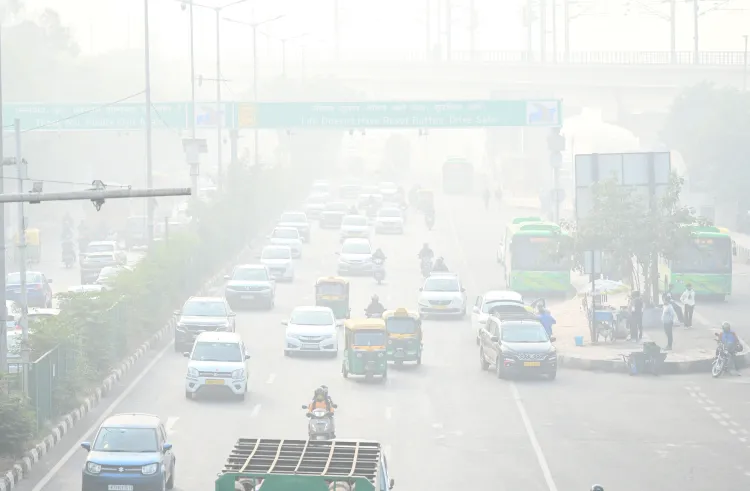Is Delhi-NCR Facing an AQI Crisis Beyond 500?

Synopsis
Key Takeaways
- AQI levels above 500 pose severe health risks.
- PM 2.5 and PM 10 concentrations are dangerously high.
- Residents are urged to stay indoors and wear masks.
- Visibility has been significantly reduced due to smog.
- Long-term solutions are needed to combat air pollution.
New Delhi, Nov 22 (NationPress) The residents of Delhi-NCR faced another alarming day of hazardous pollution on Saturday, with air quality levels plummeting into the ‘severe plus’ category, significantly jeopardizing public health. As per the air quality tracker aqi.in, Delhi recorded a concerning Air Quality Index (AQI) of 447 at 7 a.m. Numerous monitoring stations reported AQI levels exceeding 500, pushing pollution into the ‘severe plus’ zone, rendering the air nearly unbreathable.
The level of PM 2.5, the most dangerous and fine particulate matter, surged to 312 micrograms per cubic metre at 7 a.m., while PM 10 levels reached 422 micrograms per cubic metre.
These figures far surpass the World Health Organisation (WHO) 24-hour safe limits. According to WHO guidelines, PM 2.5 should remain below 15 micrograms per cubic metre, and PM 10 should not exceed 45 micrograms per cubic metre, indicating that the current levels are more than 20 times higher than the recommended thresholds.
Residents in Delhi, Noida, Ghaziabad, Faridabad, and Gurgaon reported waking up to a dense layer of smog that has lingered throughout the week.
Visibility has sharply declined, remaining between 800 and 900 metres on Friday morning, as indicated by the Early Warning System for Delhi. This persistently low visibility has disrupted daily activities and heightened health concerns, particularly among vulnerable populations.
Air quality in surrounding regions also reflects a dire situation. Greater Noida recorded an AQI of 495 at 7 a.m., dangerously close to the maximum limit of the index. Noida followed with 462, Faridabad with 448, Gurgaon with 454, and Meerut with 443, all categorized as ‘severe’.
The weather has exacerbated the situation. Morning fog is predicted to persist across major cities like Delhi, while daytime temperatures are expected to remain cool, with highs around 24 degrees Celsius. Early Saturday saw many areas of the national Capital engulfed in thick smog, offering little respite throughout the day.
Night-time temperatures have also dropped significantly. At the Safdarjung weather station, the minimum temperature fell to 11.2 degrees Celsius on Friday, which is 1.1 degrees lower than normal and slightly lower compared to Thursday’s readings. Forecasts predict temperatures may fluctuate between 9 degrees Celsius and 11 degrees Celsius in the coming days.
As pollution levels stay hazardous and the cold intensifies, health experts recommend that residents remain indoors as much as possible, wear high-quality masks, and refrain from strenuous outdoor activities.
The deteriorating conditions have once again raised urgent discussions about sustainable solutions to the recurring winter air pollution crisis faced by Delhi-NCR.








